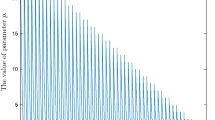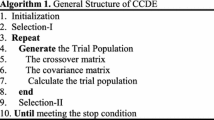Abstract
This paper presents adaptive guided differential evolution algorithm (AGDE) for solving global numerical optimization problems over continuous space. In order to utilize the information of good and bad vectors in the DE population, the proposed algorithm introduces a new mutation rule. It uses two random chosen vectors of the top and the bottom 100p% individuals in the current population of size NP while the third vector is selected randomly from the middle [NP-2(100p %)] individuals. This new mutation scheme helps maintain effectively the balance between the global exploration and local exploitation abilities for searching process of the DE. Besides, a novel and effective adaptation scheme is used to update the values of the crossover rate to appropriate values without either extra parameters or prior knowledge of the characteristics of the optimization problem. In order to verify and analyze the performance of AGDE, Numerical experiments on a set of 28 test problems from the CEC2013 benchmark for 10, 30, and 50 dimensions, including a comparison with classical DE schemes and some recent evolutionary algorithms are executed. Experimental results indicate that in terms of robustness, stability and quality of the solution obtained, AGDE is significantly better than, or at least comparable to state-of-the-art approaches.











Similar content being viewed by others
References
Storn R, Price K (1995) Differential evolution—a simple and efficient adaptive scheme for global optimization over continuous spaces. Technical Report TR-95-012, ICSI. http://icsi.berkeley.edu/~storn/litera.html. Accessed 16 June 2016
Storn R, Price K (1997) Differential evolution—a simple and efficient heuristic for global optimization over continuous spaces. J Glob Optim 11(4):341–359
Price K, Storn R, Lampinen J (2005) Differential evolution: a practical approach to global optimization. Springer, Heidelberg
Li X, Yin M (2014) Modified differential evolution with self-adaptive parameters method. J Comb Optim 31(2):546–576
Wang Y, Li H-X, Huang T, Li L (2014) Differential evolution based on covariance matrix learning and bimodal distribution parameter setting. Appl Soft Comput 18:232–247
Zhu H, He Y, Tsang E, Xi-zhao W (2017) Discrete differential evolution for the discounted {0–1} knapsack problem. J Bio Inspir Comput (Accepted in June 2017)
Hachicha N, Jarboui B, Siarry P (2011) A fuzzy logic control using a differential evolution algorithm aimed at modeling the financial market dynamics. Inf Sci 181(1):79–91
Dong C-R, Ng WWY, Wang X-Z, Chan PPK, Yeung DS (2014) An improved differential evolution and its application to determining feature weights in similarity-based clustering. Neurocomputing 146:95–103. 10.1016/j.neucom.2014.04.065
El-Quliti SA, Ragab AH, Abdelaal R et al (2015) Anonlinear goal programming model for university admission capacity planning with modified differential evolution algorithm.Math Probl Eng 2015:13
El-Qulity SA, Mohamed AW (2016) A generalized national planning approach for admission capacity in higher education: a nonlinear integer goal programming model with a novel differential evolution algorithm. Comput Intell Neurosci 2016:14
El-Quliti SA, Mohamed AW (2016) Alarge-scale nonlinear mixedbinary goal programming model to assess candidate locations for solar energy stations: an improved binary differential evolution algorithm with a case study. J Comput Theor Nanosci 13(11):7909–7921
Greenwood GW (2009) Using differential evolution for subclass of graph theory problems. IEEE Trans Evol Comput 13(5):1190–1192
Noman N, Iba H (2008) Accelerating differential evolution using an adaptive local search. IEEE Trans Evol Comput 12(1):107–125
Das S, Abraham A, Chakraborty UK, Konar A (2009) Differential evolution using a neighborhood based mutation operator. IEEE Trans Evol Comput 13(3):526–553
Lampinen J, Zelinka I (2000) On stagnation of the differential evolution algorithm. In: Matoušek R, Ošmera P, editors. Proceedings of Mendel 2000, 6th international conference on soft computing, pp 76–83
Das SS, Suganthan PN (2011) Differential evolution: a survey of the state-of-the-art. IEEE Trans Evol Comput 15(1):4–31
Liang JJ, Qin BY, Suganthan PN, Hernndez-Diaz AG (2013) Problem definitions and Evaluation Criteria for the CEC 2013 Special Session on Real-Parameter Optimization, Zhengzhou University/Nanyang Technological University, Zhengzhou, China/Singapore, Technical Report 201212
Fan HY, Lampinen J (2003) A trigonometric mutation operation to differential evolution. J Glob Optim 27(1):105–129
Mallipeddi R, Suganthan PN, Pan QK, Tasgetiren MF (2011) Differential evolution algorithm with ensemble of parameters and mutation strategies. Appl Soft Comput 11(2):1679–1696
Gamperle R, Muller SD, Koumoutsakos P (2002) A parameter study for differential evolution. In: Gremla A, Mastorakis NE (eds) Advances in intelligent systems, fuzzy systems, evolutionary computation. WSEAS Press, Interlaken, pp 293–298
Ronkkonen J, Kukkonen S, Price KV (2005) Real parameter optimization with differential evolution. In: Proceedings of the IEEE congress evolutionary computation (CEC-2005), vol 1. IEEE Press, Piscataway, pp 506–513
Zaharie D (2003) Control of population diversity and adaptation in differential evolution algorithms. In: Matousek R, Osmera P (eds) 9th international conference on soft computing proceedings of mendel 2003, pp 41–46
Liu J, Lampinen J (2005) A fuzzy adaptive differential evolution algorithm. Soft Comput 9(6):448–462
Brest J, Greiner S, Bošković B, Mernik M, žumer V (2006) Self-adapting control parameters in differential evolution: a comparative study on numerical benchmark problems. IEEE Trans Evol Comput 10(6):646–657
Omran M, Salman A, Engelbrecht A (2005) Self-adaptive differential evolution. Lect Notes Artif Intell 3801:192–199
Qin AK, Huang VL, Suganthan PN (2009) Differential evolution algorithm with strategy adaptation for global numerical optimization. IEEE Trans Evol Comput 13(2):398–417
Wang Y, Cai Z, Zhang Q (2011) Differential evolution with composite trial vector generation strategies and control parameters. IEEE Trans Evol Comput 15(1):55–66
Caraffini F, Neri F, Cheng J, Zhang G, Picinail L, Iacca G, Mininno E (2013) Super-fit multicriteria adaptive differential evolution. In: 2013 IEEE congress on evolutionary computation (CEC). IEEE, New York, pp 1678–1685
Zhang J, Sanderson AC (2009) JADE: adaptive differential evolution with optional external archive. IEEE Trans Evol Comput 13(5):945–958
Islam S, Das S, Ghosh S, Roy S, Suganthan PN (2012) An adaptive differential evolution algorithm with novel mutation and crossover strategies for global numerical optimization. Syst Man Cybern Part B Cybern IEEE Trans 42(2):482–500
Mohamed AW, Sabry HZ, Farhat A (2011) Advanced differential evolution algorithm for global numerical optimization. In: Proceedings of the IEEE international conference on computer applications and industrial electronics (ICCAIE’11), pp 156–161. Penang, Malaysia, December 2011
Mohamed AW (2017) A novel differential evolution algorithm for solving constrained engineering optimization problems. J Intell Manuf. doi:10.1007/s10845-017-1294-6
Mohamed AW (2015) An improved differential evolution algorithm with triangular mutation for global numerical optimization. Comput Ind Eng 85:359–375
Feoktistov V (2006) Differential evolution: in search of solutions. Springer, Berlin
Wang Y, Liu Z-Z, Li J, Li H-X, Wang J (2017) On the selection of solutions for mutation in differential evolution. Front Comput Sci. doi:10.1007/s11704-016-5353-5 (in press)
Wang Y, Liu Z-Z, Li J, Li H-X, Yen GG (2016) Utilizing cumulative population distribution information in differential evolution. Appl Soft Comput 48:329–346
Mohamed AW, Hadi AA, Fattouh AM, Jambi KM (2017) LSHADE with semi-parameter adaptation hybrid with CMA-ES for solving CEC 2017 benchmark problems. In: 2017 IEEE Congress on Evolutionary Computation (CEC), San Sebastian, pp 145–152. doi:10.1109/CEC.2017.7969307
Mohamed AW (2017) Solving large-scale global optimization problems using enhanced adaptive differential evolution algorithm. Complex Intell Syst 1–27. doi:10.1007/s40747-017-0041-0
Ghosh A, Das S, Chowdhury A, Giri R (2011) An improved differential evolution algorithm with fitness-based adaptation of the control parameters. Inf Sci 181(18):3749–3765
Ali MM, Törn A (2004) Population set based global optimization algorithms: some modifications and numerical studies. Comput Oper Res 31:1703–1725
Zhang X, Chen W, Dai C, Cai W (2010) Dynamic multi-group self-adaptive differential evolution algorithm for reactive power optimization. Int J Electr Power 32:351–357
Feng X, Zou R, Yu H (2015) A novel optimization algorithm inspired by the creative thinking process. Soft Comput 19(10):2955–2972
Hansen N, Műller SD, Koumoutsakos P (2003) Reducing the time complexity of the derandomized evolution strategy with covariance matrix adaptation (CMA-ES). Evolut Comput 11(1):1–18
Li X, Yao X (2012) Cooperatively coevolving particle swarms for large scale optimization. IEEE Trans Evol Comput 16(2):210–224
García S, Molina D, Lozano M, Herrera F (2009) A study on the use of non-parametric tests for analyzing the evolutionary algorithms’ behavior: a case study on the CEC’2005 special session on real parameter optimization. J Heuristics 15:617–644
Acknowledgements
The author would like to thank Deanship of Scientific Research at Majmaah University for supporting this work.
Author information
Authors and Affiliations
Corresponding author
Ethics declarations
Conflict of interest
Ali Wagdy Mohamed and Ali Khater Mohamed declare that he has no conflict of interest.
Human participants or animals
This article does not contain any studies with human participants or animals performed by any of the authors.
Rights and permissions
About this article
Cite this article
Mohamed, A.W., Mohamed, A.K. Adaptive guided differential evolution algorithm with novel mutation for numerical optimization. Int. J. Mach. Learn. & Cyber. 10, 253–277 (2019). https://doi.org/10.1007/s13042-017-0711-7
Received:
Accepted:
Published:
Issue Date:
DOI: https://doi.org/10.1007/s13042-017-0711-7




